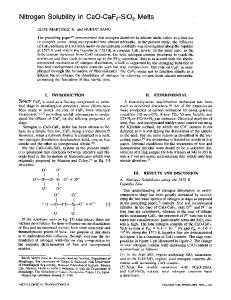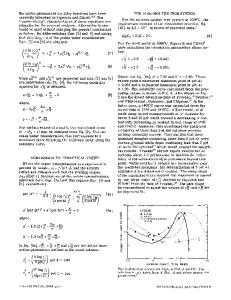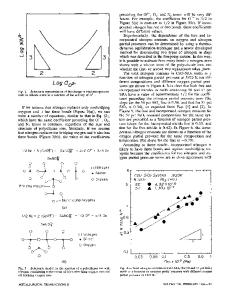Solubility of some transition metal oxides in cryolite-alumina melts: Part II. Solubility of TiO 2
- PDF / 116,941 Bytes
- 5 Pages / 612 x 792 pts (letter) Page_size
- 58 Downloads / 280 Views
CTION
IN most cases, titanium is considered to be an unwanted impurity in the Hall–He´roult bath. According to Sterten et al.,[1] titanium is present in the bath as a polyvalent species that reduces the current efficiency (CE) by (0.24 ⫾ 0.14) pct per 0.01 wt pct; Deininger and Gerlach[2] found the reduction in CE to be 0.75 pct for each 0.01 wt pct titanium. The possibility of producing aluminum-titanium alloys by electrolysis, as discussed by Qiu et al.[3] and by Devyatkin et al.,[4] is another reason for an investigation. Madhavan et al.[5] studied the ternary system Na3AlF6-NaCl-TiO2 with regard to a possible application of these mixtures as electrolytes for the electrodeposition of titanium, especially in electroplating. According to Makyta et al.,[6] titanium diboride (TiB2) comes closest to meeting the strict requirements for an “ideal” cathode lining material in the Hall–He´roult cell. TiB2 exhibits a high melting point and hardness and a high electronic conductivity, it is wetted by molten aluminum, and it is resistant toward chemical attack by both aluminum and cryolite-alumina melts. A possible way of producing TiB2 is by electrolysis of cryolite electrolytes containing B2O3 and TiO2, although Makyta et al.[6] investigated the system and found that the coatings of TiB2 prepared were of poor quality, being inhomogeneous and not coherent. Another problem observed was the escape of gaseous BF3, leading to a continuous decrease in the boron content. Dionne et al.[7] characterized TiB2-carbon composites after immersion in the bath for various periods of time and found that TiB2 particles were partially dissolved by the bath, with TROND E. JENTOFTSEN, formerly Doctoral Student, Department of Materials Technology and Electrochemistry, Norwegian University of Science and Technology (NTNU), is Senior Engineer, Hydro Aluminium AS, ˚ rdal, NO-6882 Øvre A ˚ rdal, Norway. ODD-ARNE Technology Centre A LORENTSEN, formerly Doctoral Student, Department of Materials Technology and Electrochemistry, NTNU, is Senior Scientist, Norsk Hydro ASA, Research Centre, NO-3907 Porsgrunn, Norway. ERNEST W. DEWING, 648 Pimlico Pl., Kingston ON K7M 5T8, Canada, is retired. Contact e-mail: [email protected] GEIR M. HAARBERG and JOMAR THONSTAD, Professors, are with the Department of Materials Technology and Electrochemistry, NTNU, NO-7491 Trondheim, Norway. Manuscript submitted December 5, 2001. METALLURGICAL AND MATERIALS TRANSACTIONS B
dissolution occurring along specific atomic planes. It was also found that the dissolution of TiB2 appears to be enhanced by the presence of Al2O3 in the solution. Several investigators have measured the solubility of TiO2 in molten cryolite, while one work has been reported on cryolite-alumina melts. Hayakawa and Kido[8] determined the solubility in cryolite to be 6.1 wt pct TiO2 at 1020 ⬚C, while Madhavan et al.,[5] Qui et al.,[3] and Sterten and Skar[9] reported, respectively, 5.2, 5.3, and 6.5 wt pct TiO2. Belyaev et al.[10] determined the solubility as 5.7 wt pct TiO2 in cryolite, and 5.0 wt pct T
Data Loading...











